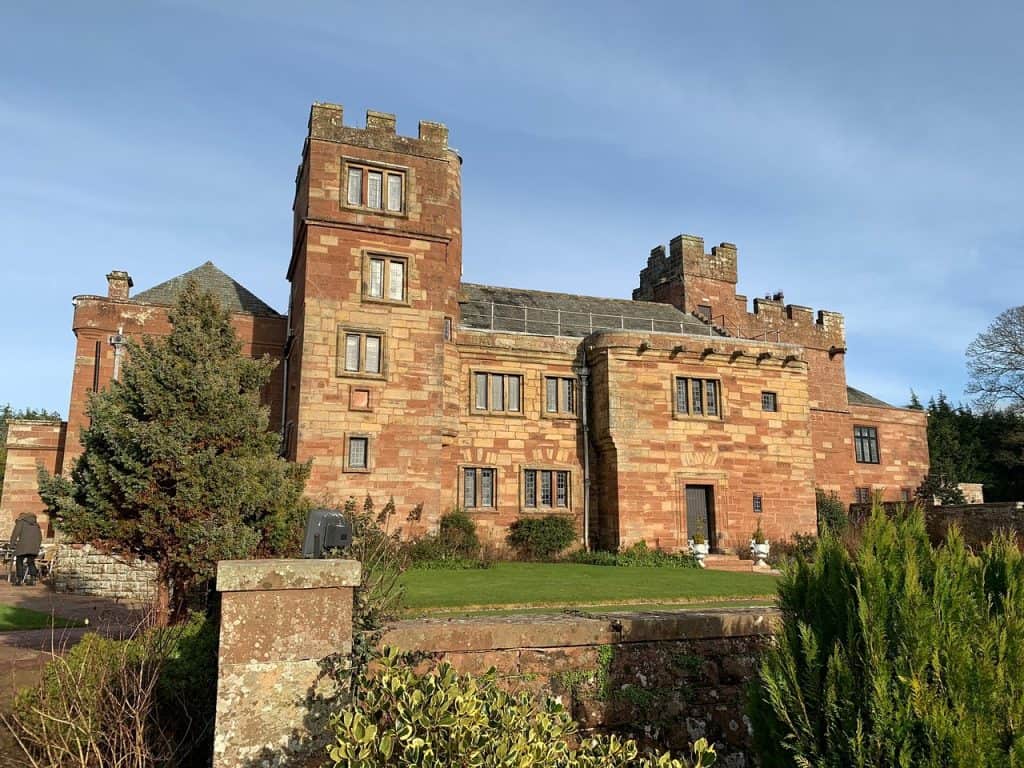Ghost Stories Read To You In A Haunted Castle

Stay Overnight In A Haunted Castle and Let Tony Walker of The Classic Ghost Stories Podcast Read You Ghost Stories In Person…
Dalston Hall’s ambiance carries whispers from the past, where history intertwines with the paranormal. For guests seeking an immersive ghost story reading experience, the hall offers an atmosphere that transcends the ordinary. Tony Walker of The Classic Ghost Stories Podcast weaves tales that come to life within these ancient walls, evoking a sense of intrigue and fascination.
As night descends upon Dalston Hall, a remarkable transformation unfolds. The ancient towers, bathed in floodlights, cast an enchanting glow upon the sandstone walls, revealing a vibrant tapestry of history. As you approach the hotel through a winding tree-lined drive, keep a watchful eye on the spectral figure of the Victorian handyman; his apparition has often graced the grounds, a lingering presence from a bygone era.

The Evening Will Consist Of:
Arrival and greeting around 6:30pm
An introduction to the ‘true’ ghosts and history of Dalston Hall, Carlisle, Cumbria, England.
Dinner in the hotel dining room with Tony.
After dinner, we retire to a private room for readings of:
The Room In The Tower by E F Benson
Especially appropriate for those of you staying in rooms in the tower…
Count Magnus by M R James
You will hear the terrors of Count Magnus by the master of the ghost story M R James
The Dark Visitor by Tony Walker
A terrifying horror story inspired and set at Dalston Hall itself
After the stories, we can sit and chat for while and make available such things as psychic readings and displays of mediumship by those who want such things.
Complimentary Copy of Further Ghost Stories by Tony Walker.
After you retire to your room, you will find a complimentary copy of Tony’s latest collection of ghost and horror stories for you to read and take home with you — if you dare.
In the morning, refreshed by a good night’s sleep, you will enjoy a full English breakfast in the dining room
Please Use This Form To Request Available Dates

Dalston Hall: A Tapestry of History
Nestled within the timeless landscapes of Cumberland, Dalston Hall unveils a captivating chronicle that has unfurled over five centuries. This venerable estate, dating back to the 16th century, stands as a sentinel to history, preserving the echoes of ages past.
The current structure of Dalston Hall, which dates back to the mid to late 15th century, is believed to have been built by John Dalston. This historic building is a testament to the architectural style of that era and has a layout that combines practicality with defense.
At the heart of the original construction was the late 15th-century Pele Tower, a fortified structure designed to serve two main purposes: defense and shelter. The tower was built to protect against external threats while also providing a safe haven for its occupants.
Access to the tower was cleverly designed through the first floor, which served various functions. This floor was used for dining, sleeping, and cooking, making it the central hub of daily life within the tower.
Moving down to the ground floor, a different aspect of the tower’s utility became evident. This level was primarily used for cellars and storage, serving as a place to store essential supplies and provisions, ensuring the self-sufficiency of the tower’s inhabitants.
Going up the tower, one would reach the upper floor, which was designated as a sleeping area. It provided a peaceful retreat, shielded by the tower’s sturdy defenses.
The top floor of the tower served as a strategic vantage point for defensive actions. From this elevated position, those inside could keep a watchful eye on the surrounding area and, if necessary, take action to protect their home.
In essence, Dalston Hall, with its timeless architecture, perfectly combined security and comfort, preserving its historical significance for generations to come.
Dalston Hall’s storied journey commences around 1500 when it was raised by the hands of John Dalston, a name etched in the annals of time. This grand edifice was more than a mere dwelling; it was a testament to power and prestige. Comprising a formidable Peel tower, a symbol of protection and might, alongside a resplendent baronial hall, it announced its presence with the inscription etched below the parapet: “Ioan Dalson Elisabet mi wyf mad ys byldyng.”
Adjacent to this inscription, intricate carvings portraying a dog and a cat further enrich the hall’s narrative.
These walls bear witness to centuries of history, with each stone resonating the stories of those who once roamed its corridors.
A Symphony of Styles
Yet, it is the building adjoining the pele tower that truly captivates with its unique motifs, a rarity in Cumberland. Hints of a Scottish influence permeate the design, breathing life into the structure. The water spouts, resembling ornate gun barrels, evoke a sense of grandeur, while the tower’s circular stair turret, gracefully perched on a corbel, bears testament to the hall’s architectural prowess. At the base, an original iron gate harks back to those found at Burgh by Sands Church, Naworth Castle, and Cawdor Castle in Scotland.
The Dalston Family
In 1092, after the annexation of Cumberland, Robert de Vaulx was granted the Norman barony of Dalston.
A similar boundary ditch, like the one at Irthington, separated the lands of the Barony of Gilsland and the lands of the Bishop of Carlisle at Crosby-on-Eden.
In 1135, David I of Scotland seized the lands that belonged to the descendants of the de Dalston family, whose surname was derived from the location of Dalston.
Henry II’s recovery of the barony in 1157 did not result in its return to the de Dalston family. Instead, it remained as crown property, forming part of the royal Forest of Inglewood.
The de Dalston family, who had been dispossessed, retained only the manor of Little Dalston, where they constructed their hall.
In 1189, a younger member of the de Dalston family was granted ownership of the manor, which remained in the family for several generations until 1761.
Records from 1295 refer to Dalston as a park.
Expansion and Dynastic Legacy
As time flowed onward, Dalston Hall continued to evolve. In 1556, the addition of a west wing elevated its grandeur, creating an architectural masterpiece that blended tradition with modernity. The hall remained under the stewardship of the Dalston family, their names interwoven with the fabric of Cumberland’s history. Within these hallowed halls, members of the Dalston clan held positions as sheriffs and Members of Parliament for the county, further solidifying their place in the region’s heritage.
Dalston Hall and the Siege of Carlisle

The 17th century bore witness to a tumultuous period in English history, with the English Civil War sweeping across the land. In the midst of this turmoil, Dalston Hall found itself entangled in the web of conflict. Sir George Dalston, a staunch Royalist and a key figure in the hall’s history, played a pivotal role during this tumultuous period. His unwavering support for the Royalist cause saw him sit in the House of Commons of England between 1621 and 1643.
Sir George Dalston’s life was inextricably linked to Dalston Hall. Born in 1581 as the eldest son of Sir John Dalston and Frances Warcop, he matriculated from Queens’ College, Cambridge, around 1596. Knighted on 26 June 1607, he assumed the role of Captain of Carlisle Castle, Cumberland, in 1608, a position he held until at least 1643. His dedication to his county extended to serving as a Justice of the Peace for Cumberland and Westmorland from 1615 to 1644. In 1618, he took on the mantle of High Sheriff of Cumberland and Custos Rotulorum of Cumberland from 1641 to 1644.
As the English Civil War raged on, the Siege of Carlisle unfolded in 1644-45. The Siege of Carlisle was the longest siege in English history, but eventually the Royalist fortress fell to the Scottish Covenanters, allies of Oliver Cromwell and the English Parliamentary Army.
During the Siege of Carlisle, Dalston Hall played a pivotal role as it was requisitioned by the Scottish General Leslie to serve as his headquarters. This historic shift in occupancy forced Sir George Dalston, the then-owner of the hall, to flee from his ancestral home. The siege, a significant episode in the English Civil War, saw Dalston Hall transformed into a center of military operations, highlighting its strategic importance during this turbulent period. George Dalston’s departure from his cherished residence marked a compelling chapter in the hall’s rich history, forever linking it to the events of that era.

Dalston Hall Since 1800
In 1761, the legacy of Dalston Hall entered a new phase when Monkhouse Davison, a London grocer, acquired the property. Davison’s ownership endured for 32 years, leaving an imprint on the hall’s narrative. However, it was in 1897 that the hall witnessed another transformative moment. Edmund Wright Stead, owner and director of Stead McAlpin, calico printers, took the helm. Under his stewardship, architect C.J. Ferguson undertook a monumental task, remodeling the frontage in red sandstone in 1899. This renovation breathed fresh life into the hall, preserving its grandeur for generations to come.
In 1761, a London grocer acquired Dalston Hall, holding ownership for 32 years until his passing. Then, in 1897, Edmund Wright Stead became the new owner. Stead initiated significant interior renovations and oversaw the construction of the entrance side of the building. This ambitious project resulted in the creation of a grand mansion, often praised as even surpassing its ancient glories by contemporary antiquarians.
Prior to its conversion into a hotel in 1971, Dalston Hall served as a youth training centre. This shift in purpose added another layer to the hall’s rich history, highlighting its adaptability and enduring relevance.
In 1984, Dalston Hall received the prestigious Grade II* listing, a testament to its historical and architectural importance.


